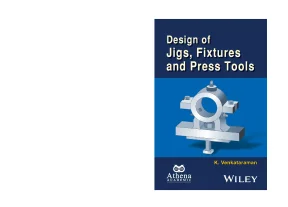Thiết Kế Jigs, Fixtures và Công Cụ Ép: Kiến Thức Cơ Bản cho Kỹ Sư Cơ Khí
2015
Phí lưu trữ
40.000 VNĐMục lục chi tiết
Tóm tắt
I. Hướng Dẫn Toàn Diện Về Thiết Kế Jigs và Fixtures
Thiết kế jigs và fixtures là một phần quan trọng trong quy trình sản xuất hiện đại. Chúng giúp tăng cường độ chính xác và hiệu quả trong việc gia công các linh kiện. Việc hiểu rõ về các khái niệm cơ bản và ứng dụng của chúng là rất cần thiết cho các kỹ sư cơ khí và sản xuất.
1.1. Định Nghĩa Jigs và Fixtures Trong Sản Xuất
Jigs và fixtures là các thiết bị hỗ trợ trong quá trình gia công, giúp định vị và giữ chặt linh kiện. Chúng đảm bảo rằng các công cụ cắt hoạt động chính xác và hiệu quả.
1.2. Lợi Ích Của Jigs và Fixtures Trong Quy Trình Sản Xuất
Việc sử dụng jigs và fixtures giúp giảm thiểu thời gian gia công, tăng độ chính xác và giảm thiểu sai sót trong sản xuất. Điều này rất quan trọng trong các ngành công nghiệp yêu cầu độ chính xác cao.
II. Các Thách Thức Trong Thiết Kế Jigs và Fixtures
Mặc dù jigs và fixtures mang lại nhiều lợi ích, nhưng việc thiết kế chúng cũng gặp phải nhiều thách thức. Các yếu tố như vật liệu, độ bền và chi phí sản xuất cần được xem xét kỹ lưỡng.
2.1. Vấn Đề Về Vật Liệu Sử Dụng Cho Jigs và Fixtures
Chọn lựa vật liệu phù hợp cho jigs và fixtures là rất quan trọng. Vật liệu cần phải có độ bền cao và khả năng chịu lực tốt để đảm bảo hiệu quả trong quá trình gia công.
2.2. Chi Phí Thiết Kế và Sản Xuất Jigs và Fixtures
Chi phí thiết kế và sản xuất jigs và fixtures có thể cao, đặc biệt là khi yêu cầu độ chính xác cao. Cần có sự cân nhắc giữa chi phí và lợi ích mang lại từ việc sử dụng chúng.
III. Phương Pháp Thiết Kế Jigs và Fixtures Hiệu Quả
Để thiết kế jigs và fixtures hiệu quả, cần áp dụng các phương pháp và công nghệ hiện đại. Việc sử dụng phần mềm thiết kế và mô phỏng có thể giúp tối ưu hóa quy trình này.
3.1. Sử Dụng Phần Mềm Thiết Kế Trong Thiết Kế Jigs
Phần mềm thiết kế CAD giúp tạo ra các mô hình 3D chính xác cho jigs và fixtures, từ đó dễ dàng điều chỉnh và tối ưu hóa thiết kế.
3.2. Các Kỹ Thuật Mô Phỏng Trong Thiết Kế Fixtures
Mô phỏng giúp kiểm tra tính khả thi của thiết kế trước khi sản xuất thực tế, giúp phát hiện sớm các vấn đề có thể xảy ra.
IV. Ứng Dụng Thực Tiễn Của Jigs và Fixtures Trong Ngành Công Nghiệp
Jigs và fixtures được ứng dụng rộng rãi trong nhiều lĩnh vực công nghiệp, từ sản xuất ô tô đến chế tạo máy móc. Chúng đóng vai trò quan trọng trong việc nâng cao năng suất và chất lượng sản phẩm.
4.1. Ứng Dụng Trong Ngành Sản Xuất Ô Tô
Trong ngành sản xuất ô tô, jigs và fixtures giúp đảm bảo rằng các linh kiện được lắp ráp chính xác, từ đó nâng cao chất lượng và độ an toàn của sản phẩm.
4.2. Vai Trò Của Jigs Trong Ngành Chế Tạo Máy
Jigs giúp tăng cường độ chính xác trong gia công các linh kiện máy móc, từ đó giảm thiểu sai sót và tăng hiệu quả sản xuất.
V. Kết Luận Về Thiết Kế Jigs Fixtures và Công Cụ Ép
Thiết kế jigs, fixtures và công cụ ép là một lĩnh vực quan trọng trong ngành cơ khí. Việc nắm vững các khái niệm và ứng dụng của chúng sẽ giúp các kỹ sư nâng cao hiệu quả sản xuất và chất lượng sản phẩm.
5.1. Tương Lai Của Thiết Kế Jigs và Fixtures
Với sự phát triển của công nghệ, thiết kế jigs và fixtures sẽ ngày càng trở nên thông minh hơn, giúp tối ưu hóa quy trình sản xuất.
5.2. Tầm Quan Trọng Của Đổi Mới Trong Thiết Kế
Đổi mới trong thiết kế jigs và fixtures sẽ giúp các doanh nghiệp duy trì tính cạnh tranh và đáp ứng nhanh chóng nhu cầu thị trường.
TÀI LIỆU LIÊN QUAN

Bạn đang xem trước tài liệu:
Design of jigs fixtures and press tools